

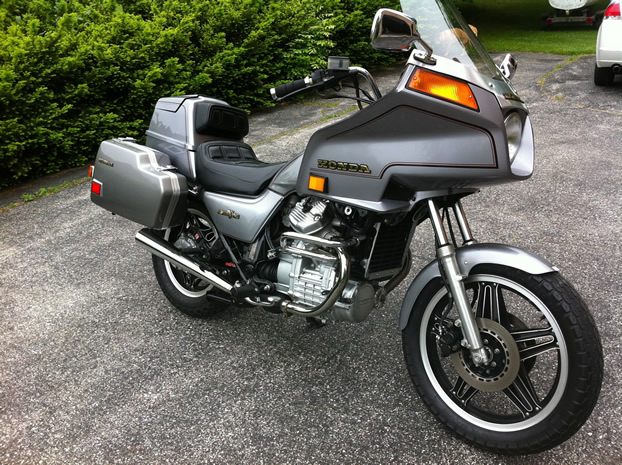
1982 GL500 SilverWing Interstate - with factory fairing, solo seat, trunk and side cases.
I searched for a while to find this bike. It has 22,000 miles on it and had been garaged since new. I have a 100-mile commute I'm starting and wanted a good solo touring bike that could also take an passenger (it came w/ a factory passenger seat as well.)
I brought the bike to our local Honda Shop - who's Service Manager owned a Turbo CX and was familiar w/ the bike. I had their shop do a full safety inspection, replace the lightly dry rotted tires with a set of Dunlop D404s, flush and replace the front brake lines & fluid, flush and change the engine coolant, new engine oil and filter & air filter, new rear shaft oil and a new set of spark plugs.
The front handlebars had a twist to the left - and the bike had a nasty speed wobble at 30-40mph.
I added a aftermarket fork brace - which was standard on upgraded GL650 Silverwings. Didn't stop the wobble though.
What was missed was a critical issue with the bike - Not only did the bike hit something - but the previous owner then tried to hide it by pulling the forks to straighten it out!
SO that meant a replacement and rebuild the entire front end.
I also found that the BRAND NEW Dunlop 404 rear tire had a nasty flat spot and wobble.
REMOVED:
Pair of bent forks, triple tree and steering head assembly.
Front wheel which has a small ding.
Front Brake Disc which is warped from all the bending.
NEW Rear Dunlop 404 tire which has flat spot and wobble - NEVER BUYING another pair of Dunlop tires again.
INSTALLED:
Used GL500 Forks with NEW Fork Seals
Used Triple Tree
Used Front wheel
Used front brake disc
New Tapered Ball Steering Head Bearing.
New Rear Kenda Kruz TOURING Tire
FINALLY the bike is RUNNING and RIDING smooth in time for Summer 2014.
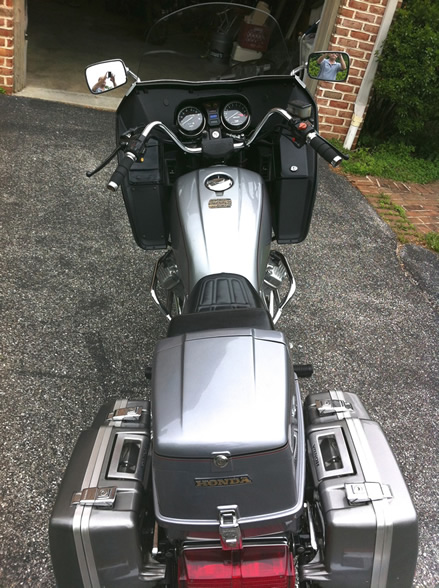
The full fairing and windscreen is borrowed from the Goldwing models.
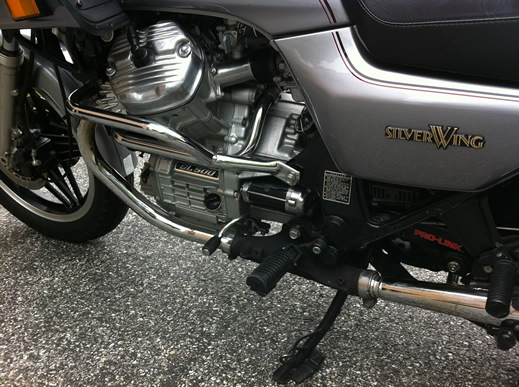
Here you see the factory Hondaline engine guard.
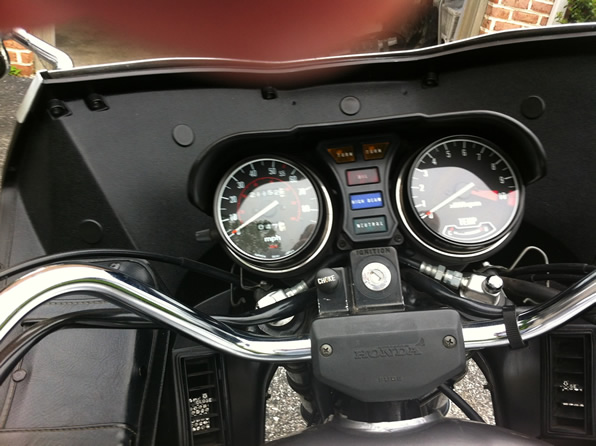
There is almost no fade on the instruments or fairing - this bike was stored indoors.
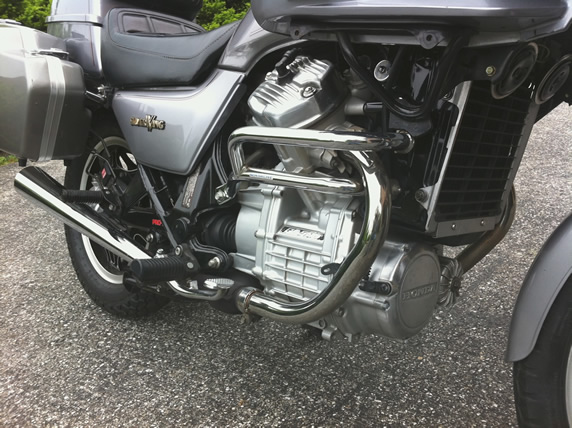
This is a torquey watercooled 500cc 80-degree V engine layout keeps the engine vibration low. This top-of-the-line 1982 model comes with a transistorized ignition, twin front disk brakes, and air adjustable forks and rear monoshock - way ahead of its time in design. Honda upgraded the bike to a 650 in 1983 and then dropped it in favor of their 4-cylinder designs.

The Interstate luggage is removable, and all lockable w/ the one bike key.
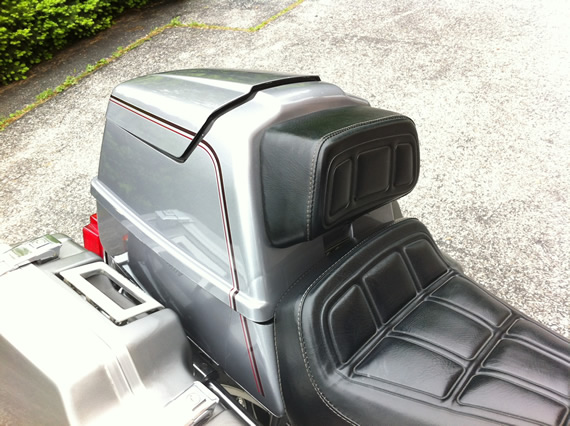
The whole setup is modular with the solo seat w/ rear truck and backrest.
AND After installing the trunk extender the bike is now set up for maximum space with all the luggage and ability to carry 2 passengers.
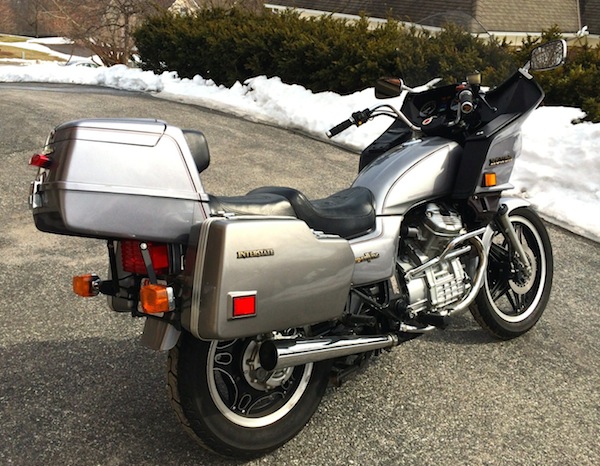
Or give the rider some extra room to stretch out. Notice how much the trunk covers the rear brake light.
I'm amazed how often I use the trunk - which opens from both the top and bottom.
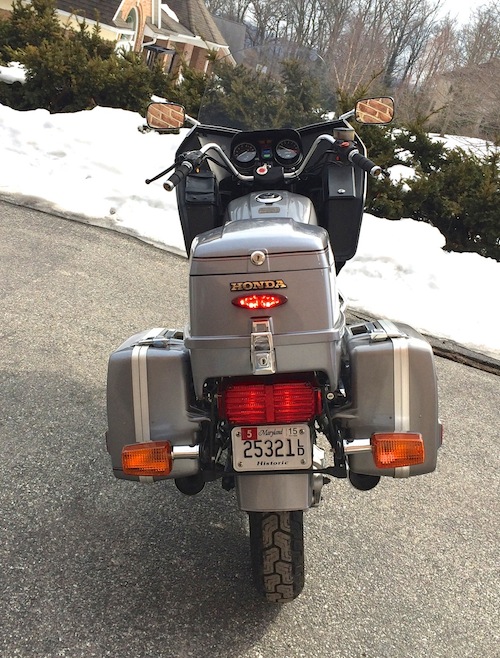
Here you see the trunk back with the LED aftermarket light installed to enhance visibility - a HIGHLY RECOMMENDED and EASY modification.
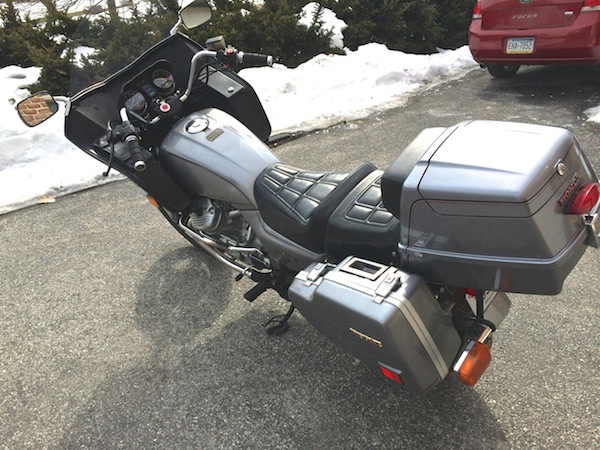
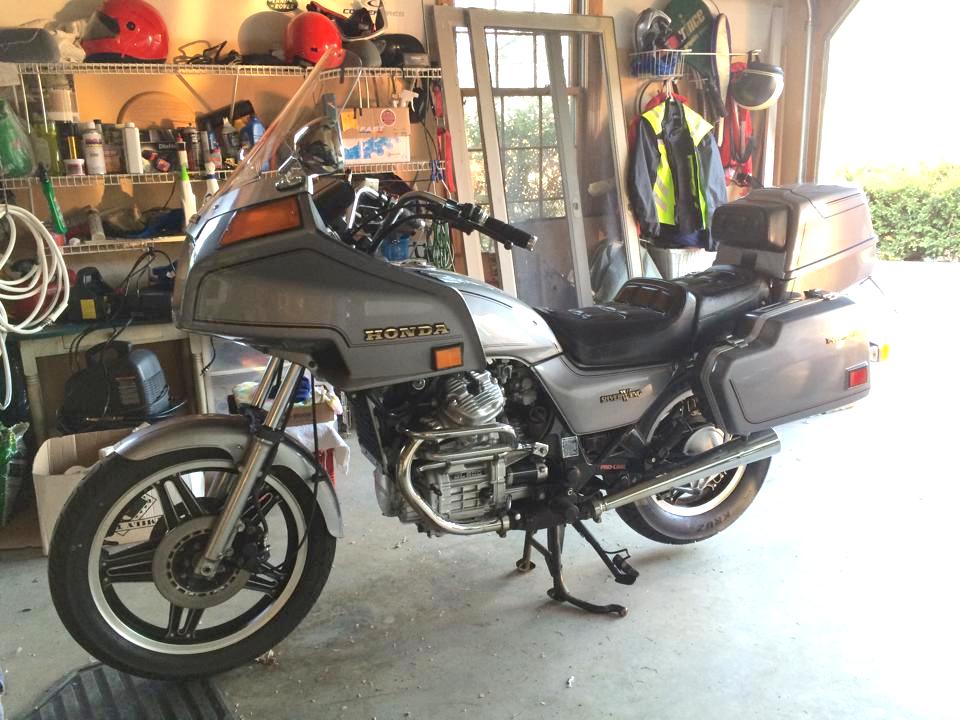
The only factory item missing were the lower front fairings.
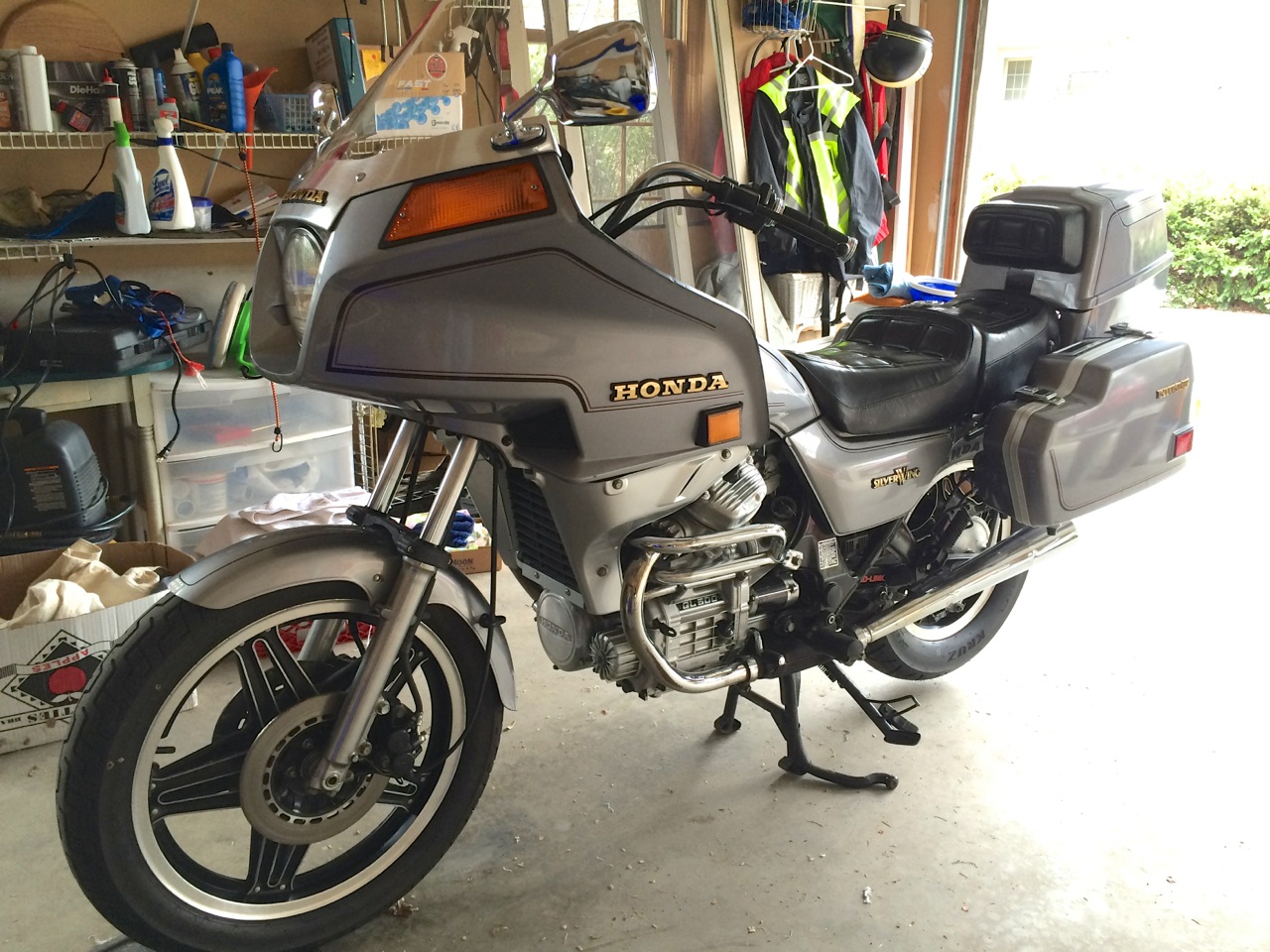
I found a used pair on ebay and painted them silver w/ several applications of clearcoat -
They came out a shade ligter silver than the paint but they will do - they come off during the Summer as does the windshield.

In June 2014 I had the front engine seal start to leak - so the bike went back in the shop.
Pulled the fairing, radiator and front covers off the motor and checked the clutch - which ended up having several badly worn discs.
So after a new set of clutch springs and gaskets, oil and filter change, and general tightening up she's back on the road.
The only other modification I did is install a voltmeter into the fairing.
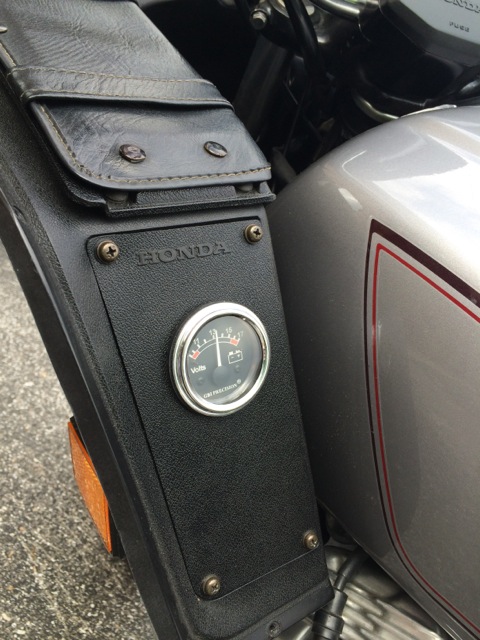
The wiring for the radio is behind the panel and makes for an easy installation.
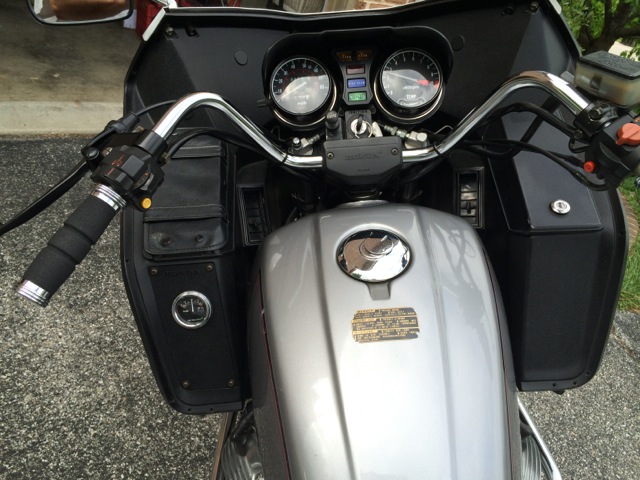
The main 30-amp metal fuse has been upgraded to an automative type, which is key upgrade to do:
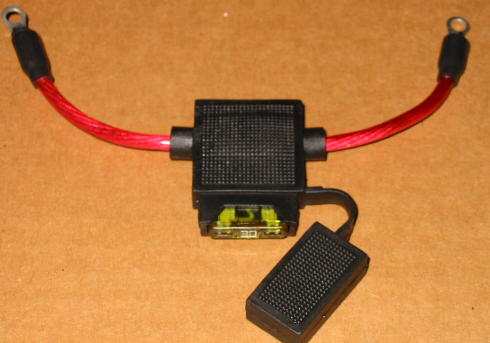
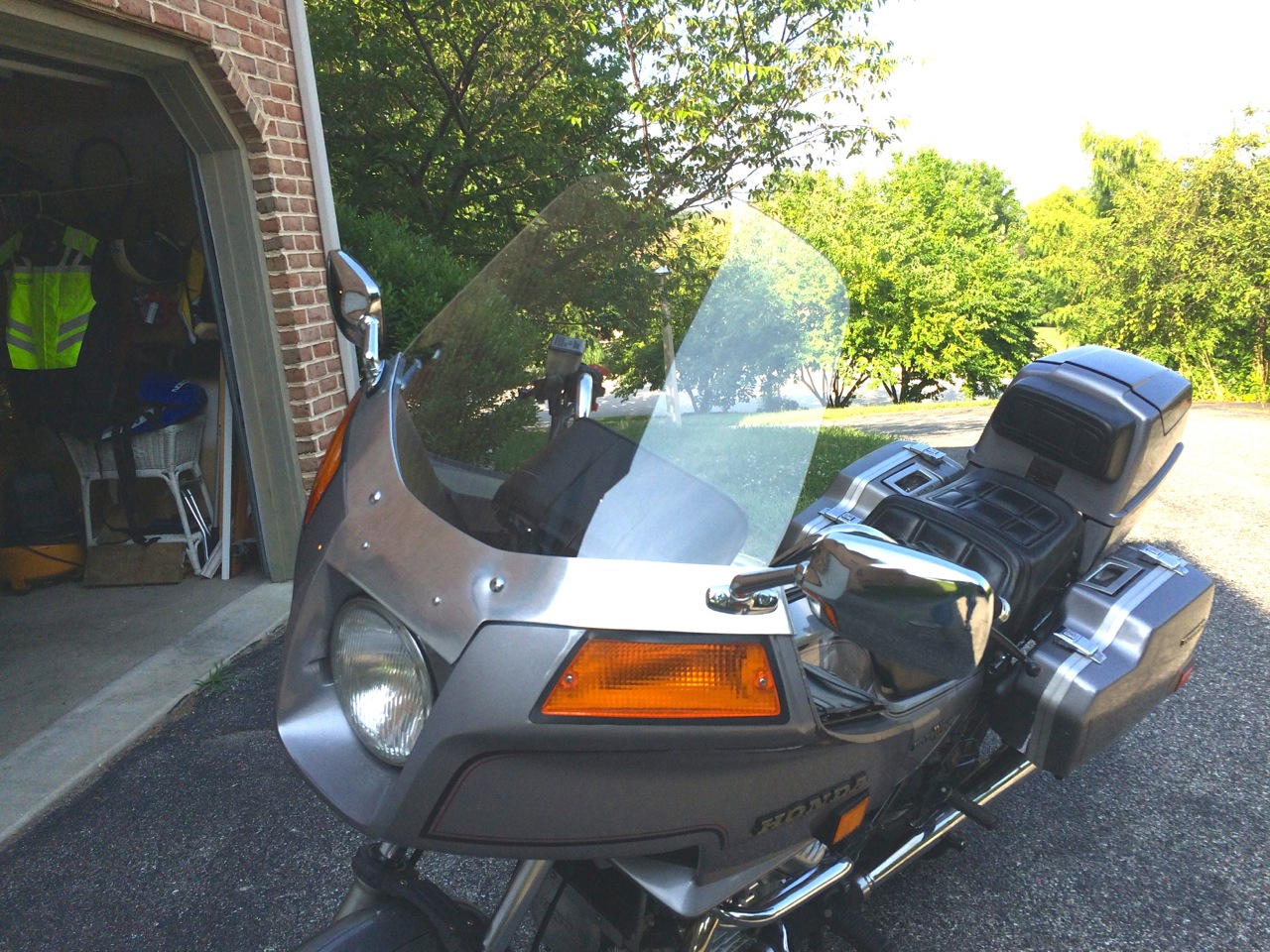

A Review from 1981 when these bikes first hit the street:
Honda GL 500 Silverwing Interstate
Liquid cooled, four-stroke. longitudinal 800 V-twin. SOHC 4 valves per cylinder operated by pushrods.
Much thought went into the design of Honda's 500-class full-dress tourer. The existing CX500 V-twin engine would obviously be the ideal choice as power plant, but what about the chassis? One faction of Honda development guys thought the best approach was to take the standard CX—engine, chassis and all and simply bolt on a fairing and some saddlebags. Another group wanted to see the pushrod V-twin powering an all-new chassis one designed from the ground up for touring use with a fairing and bags, something with more advanced engineering and clean, integrated styling.
Luckily for the middleweight touring rider, Honda finally settled on the latter approach. What they came up with has been dubbed the GL500I Silver Wing Interstate, essentially a smaller version of the GL1100 Interstate introduced last year. Since both machines are fitted with the same injection-molded plastic fairing, the similarities in the styling of the two bikes are striking. No other pieces interchange, however; the GL500 is built entirely as a 500-class machine.
The GL500 is available two ways: fully dressed and ready for open-road work, or stripped-down without the fairing and saddlebags (the version we tested in our June middleweight comparison). The only mechanical difference between the two machines is in the front brake. The Interstate has dual discs and Honda's twin-piston calipers, while the stripped-down GL has one larger diameter disc and a single twin-piston caliper. In virtually all other respects, the two GLs are identical.
The four-valve twin that powers the Interstate is pretty much the same unit that has seen action in the CX500 for the past few years. The only differences are a change from magneto CDI to transistorized ignition and longer intake manifolds to provide a more inboard carburetor location. The little plain-bearing V-twin is a willing revver redline is 9700 rpm. Low (high numerically) gearing has the GL spinning a brisk 5395 rpm at 60 mph in top gear, but the 80-degree V engine layout keeps vibration comfortably low. Engine and drive-line maintenance are simple on the GL, since the water-cooled engine is equipped with easy-to-service, threaded valve adjusters and low-maintenance shaft final drive. There's enough horsepower on hand to push the Interstate through the quarter-mile in 14.94 seconds at 86.04 mph—or about a second slower than the unfaired GL. The Interstate's roll-on terminal speed after 200 yards from 50 mph in top gear is 67.6 mph—only two mph slower than the GL's. The Interstate isn't particularly big on mid-range power, but it is carbureted cleanly and builds its power predictably as the revs rise. The GL can easily work up enough speed to exceed the national limit when fully loaded, but steep hills and high altitudes often require a downshift or two and plenty of revving. High engine speeds send a healthy buzz through the pegs and drop the fuel mileage considerably. Our test bike occasionally turned in tankfuls that ran in the low 30s when pushing strong headwinds and climbing steep hills.
Since it employs the same gearbox and clutch as has been used in the CX500 since its introduction, the GL can be a balky shifter. Upshifts must be executed deliberately to prevent occasional missed shifts. During drag-strip-type speed shifts the GL's clutch slips. Luckily, this type of shifting abuse isn't standard fare for touring riders. The clutch has its good points during normal use. The lever pull is light and the engagement smooth and predictable.
The four-valve engine is an excellent basis for a middleweight dresser, but just as important is its chassis. It is entirely new, and incorporates a number of features to make it a better touring platform. The GL's wheelbase is longer than the CX500's, and the steering geometry is slower to provide more stability. Even with these changes, the Interstate steers lightly and easily. There's also a bit more suspension travel at each end to better handle bumps and potholes. Suspension-wise, the GL has a lot more on the CX than just travel. Instead of the CX's conventional dual-shock rear suspension, the GL has Honda's Pro-Link system. A single shock is mounted vertically between the swingarm and engine, and is connected to the swing-arm with a linkage. This linkage delivers rising-rate suspension geometry, meaning that the farther the suspension compresses, the more the shock's leverage deficit is reduced. This progressivity keeps the suspension soft and responsive to small bumps, while allowing it to become stiffer to handle big bumps. The Showa damper has fixed damping and a straight-rate coil spring. An adjustable air spring built into the shock lets you fine-tune the suspension action to suit load and riding conditions. The pressure can be set anywhere between zero and 70 psi, so there's plenty of room for adjustment.
The Pro-Link makes the GL the smoothest-riding middleweight on the highway. The rear suspension is very responsive to small lips and seams in the pavement. There's little of the usual spine-pounding on those cursed freeway expansion joints, so long hours on the super-slab seem to pass more quickly. Thanks to the progressive geometry and air springing, the Pro-Link eats up the big bumps too. With the air pressure adjusted to cope with the rider and cargo weight, bottoming isn't noticeable. The only drawback to the system is the shock's marginal rebound damping. The light damping undoubtedly contributes to the excellent responsiveness on small bumps, but it isn't sufficient to keep things under control when the shock rebounds after a big impact. The back end of the Honda pogos somewhat on bumpy roads, occasionally badly enough to bounce the rider up off the seat during fast riding. The same damping insufficiency contributes to a chassis instability on high-speed corners. The Interstate isn't the appropriate tool to use to hone your road-racing skills, and isn't intended to be. However, a bit more rebound damping would improve the bike's handling under almost all conditions, while only sacrificing a tiny portion of its butter-smooth ride on the highway. We experienced the same damping shortage on the standard GL, too.
The front fork nearly matches the responsiveness of the Pro-Link, but delivers far more wheel control. The air/ spring fork's stanchion tubes can be inflated at a common filler, so adjustments are simple. Honda's dual syntal-lic bushings cut down on stiction to make the fork more responsive to sharp lips and jolts. The 35mm Showa fork never bottoms noticeably, even during hard braking on large bumps, provided the air pressure is jacked up sufficiently in advance.
Honda didn't cut corners in the braking department either. Up front, a pair of discs are gripped by powerful, dual piston calipers. A two-fingered squeeze on the lever will bring the front brake to the point of lock-up, and the feel is excellent. In the rear, the single-leading-shoe drum-type brake is adequate.
Though the chassis bits are all pretty decent stuff, they're outshone by the slick touring gear. The large fairing has an adjustable windscreen and pro vides excellent protection. Even tall riders easily fit within the pocket of calm air created by the fairing. The fairing-mounted mirrors vibrate somewhat and are positioned far away from the rider, so the images are small and blurred at certain engine speeds. Small adjustable vents built into the fairing are intended to let fresh air in behind the fairing if desired, but they are too small to be effective. Honda offers an optional AM/FM radio, a clock and a voltmeter to mount in the fairing dash. Though the upper-body wind protection is excellent, the abbreviated fairing-lowers leave your lower legs in the wind. On hot days, this is a blessing, since hot air from the engine's radiator fills the calm air envelope and makes the rider uncomfortably hot. Of course, on cold rides this heat keeps the rest of your body warm while your legs are chilled. Two compartments in the fairing provide storage space and can handle five pounds each. The one on the left has a snap-down vinyl cover; the right one's plastic lid locks with the ignition key.
The Interstate comes equipped with a decent, though not remarkably good, solo saddle and storage trunk. If you wish to carry a passenger, the trunk must be unbolted and replaced with the passenger seat included with the bike. The lockable trunk can handle 20 pounds worth of gear, and is much larger than the compact trunk that comes standard on the stripped-down, unfaired GL500. The smaller trunk can be purchased separately as an accessory.
The saddlebags are nicely finished, detachable units that lock shut and in place on the bike. They feature sturdy aluminum frames with rubber gaskets to keep water out and internal elastic straps that make it easy to secure the contents. Honda suggests that each bag be loaded with no more than 20 pounds worth of cargo. The bags are deeper than those on the CBX, so they hold considerably more. Our only complaint is with the overly complicated mounting system that uses several latching mechanisms, including seat belt-type buckles and locking arms. The bag-mounting mechanisms on the CBX are much simpler, and they don't pinch your fingers. Like all the locks on the bike, the bags' locks are operated by the ignition key.
At least for the moment, Honda's GL500 Interstate is literally in a class by itself. No other manufacturer currently offers a ready-to-ride, full-dress middleweight tourer, so the only alternative to the Honda is to do it yourself. If you go that route, it's unlikely that you'll come up with anything that will match the integration, fit and excellent finish of the Silver Wing Interstate.
Source: Motorcyclist 1981